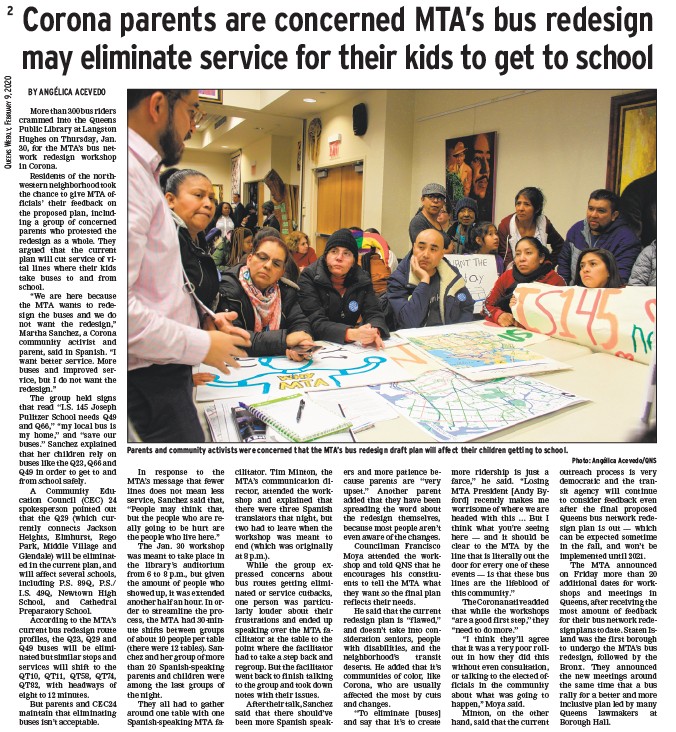
2
QUEENS WEEKLY, FEBRUARY 9, 2020
Corona parents are concerned MTA’s bus redesign
may eliminate service for their kids to get to school
BY ANGÉLICA ACEVEDO
More than 300 bus riders
crammed into the Queens
Public Library at Langston
Hughes on Thursday, Jan.
30, for the MTA’s bus network
redesign workshop
in Corona.
Residents of the northwestern
neighborhood took
the chance to give MTA officials’
their feedback on
the proposed plan, including
a group of concerned
parents who protested the
redesign as a whole. They
argued that the current
plan will cut service of vital
lines where their kids
take buses to and from
school.
“We are here because
the MTA wants to redesign
the buses and we do
not want the redesign,”
Martha Sanchez, a Corona
community activist and
parent, said in Spanish. “I
want better service. More
buses and improved service,
but I do not want the
redesign.”
The group held signs
that read “I.S. 145 Joseph
Pulitzer School needs Q49
and Q66,” “my local bus is
my home,” and “save our
buses.” Sanchez explained
that her children rely on
buses like the Q23, Q66 and
Q49 in order to get to and
from school safely.
A Community Education
Council (CEC) 24
spokesperson pointed out
that the Q29 (which currently
connects Jackson
Heights, Elmhurst, Rego
Park, Middle Village and
Glendale) will be eliminated
in the current plan, and
will affect several schools,
including P.S. 89Q, P.S./
I.S. 49Q, Newtown High
School, and Cathedral
Preparatory School.
According to the MTA’s
current bus redesign route
profiles, the Q23, Q29 and
Q49 buses will be eliminated
but similar stops and
services will shift to the
QT10, QT11, QT58, QT74,
QT82, with headways of
eight to 12 minutes.
But parents and CEC24
maintain that eliminating
buses isn’t acceptable.
Parents and community activists were concerned that the MTA’s bus redesign draft plan will affect their children getting to school.
Photo: Angélica Acevedo/QNS
In response to the
MTA’s message that fewer
lines does not mean less
service, Sanchez said that,
“People may think that,
but the people who are really
going to be hurt are
the people who live here.”
The Jan. 30 workshop
was meant to take place in
the library’s auditorium
from 6 to 8 p.m., but given
the amount of people who
showed up, it was extended
another half an hour. In order
to streamline the process,
the MTA had 30-minute
shifts between groups
of about 10 people per table
(there were 12 tables). Sanchez
and her group of more
than 20 Spanish-speaking
parents and children were
among the last groups of
the night.
They all had to gather
around one table with one
Spanish-speaking MTA facilitator.
Tim Minton, the
MTA’s communication director,
attended the workshop
and explained that
there were three Spanish
translators that night, but
two had to leave when the
workshop was meant to
end (which was originally
at 8 p.m.).
While the group expressed
concerns about
bus routes getting eliminated
or service cutbacks,
one person was particularly
louder about their
frustrations and ended up
speaking over the MTA facilitator
at the table to the
point where the facilitator
had to take a step back and
regroup. But the facilitator
went back to finish talking
to the group and took down
notes with their issues.
After their talk, Sanchez
said that there should’ve
been more Spanish speakers
and more patience because
parents are “very
upset.” Another parent
added that they have been
spreading the word about
the redesign themselves,
because most people aren’t
even aware of the changes.
Councilman Francisco
Moya attended the workshop
and told QNS that he
encourages his constituents
to tell the MTA what
they want so the final plan
reflects their needs.
He said that the current
redesign plan is “flawed,”
and doesn’t take into consideration
seniors, people
with disabilities, and the
neighborhood’s transit
deserts. He added that it’s
communities of color, like
Corona, who are usually
affected the most by cuts
and changes.
“To eliminate buses
and say that it’s to create
more ridership is just a
farce,” he said. “Losing
MTA President Andy Byford
recently makes me
worrisome of where we are
headed with this … But I
think what you’re seeing
here — and it should be
clear to the MTA by the
line that is literally out the
door for every one of these
events — is that these bus
lines are the lifeblood of
this community.”
The Corona native added
that while the workshops
“are a good first step,” they
“need to do more.”
“I think they’ll agree
that it was a very poor rollout
in how they did this
without even consultation,
or talking to the elected officials
in the community
about what was going to
happen,” Moya said.
Minton, on the other
hand, said that the current
outreach process is very
democratic and the transit
agency will continue
to consider feedback even
after the final proposed
Queens bus network redesign
plan is out — which
can be expected sometime
in the fall, and won’t be
implemented until 2021.
The MTA announced
on Friday more than 20
additional dates for workshops
and meetings in
Queens, after receiving the
most amount of feedback
for their bus network redesign
plans to date. Staten Island
was the first borough
to undergo the MTA’s bus
redesign, followed by the
Bronx. They announced
the new meetings around
the same time that a bus
rally for a better and more
inclusive plan led by many
Queens lawmakers at
Borough Hall.